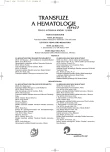Anagrelide in the treatment of thrombocytosis in myeloproliferative disease – case report
Anagrelid v terapii trombocytózy u myeloproliferativního onemocnění – Kazuistika
Anagrelid jako specifický perorální netoxický inhibitor trombopoézy je dnes již lékem volby u pacientů s histologicky ověřeným myeloproliferativním syndromem (MPS) typu esenciální trombocytemie. Tato léčba výrazně zlepšuje jak kvalitu života, tak prognózu onemocnění. V odborné literatuře však nacházíme popisy případů příznivého účinku této léčby i u dalších typů myeloproliferativních syndromů včetně primární polycytemie, idiopatické myelofibrózy a chronické myeloidní leukemie. Autorka popisuje případ využití anagrelidu jako třetí volbu léčby u pacientky s diagnózou MPS, podle kritérií PVSG zařazené jako esenciální trombocytemie, ale podle nových klasifikačních kritérií WHO jako prefibrotické stadium myelofibrózy. Anagrelid je u této choroby velmi efektivním způsobem léčby, dokonce v relativně nízkých dávkách 1,0–1,5 mg denně.
Klíčová slova:
anagrelid, myeloproliferativní onemocnění, esenciální trombocytemie, idiopatická myelofibróza
Authors:
J. Pelková
Authors‘ workplace:
Hematologicko-transfuzní oddělení, Baťova krajská nemocnice Zlín
Published in:
Transfuze Hematol. dnes,12, 2006, No. 2, p. 104-106.
Category:
Comprehensive Reports, Original Papers, Case Reports
Overview
There is presented a case report of using anagrelide hydrochloride as a non-toxic oral inhibitor of thrombopoiesis in chronic myeloproliferative disorders (MPD). It is the first medicament to use for patients with histopathologically verified MPD – essential thrombocytosis. This treatment carries very good benefit for the quality of life. In medical literature we find reports where this therapy is used also in other types of MPD such as polycythaemia vera, chronic myelogenous leukaemia and myelofibrosis with myeloid metaplasia. We report our experience with using anagrelide as the third line therapy in patient with a diagnosis of MPD – by the PVSG rules – the essential thrombocytosis, but by the new WHO classification is as praefibrotic phase of chronic idiopathic myelofibrosis. In conclusion – anagrelide is an effective drug in the treatment of this disease, even in relatively low dose 1.0–1.5 mg per day.
Key words:
anagrelide, chronic myeloproliferative disorders, essential thrombocythaemia, chronic idiopathic myelofibrosis
Labels
Haematology Internal medicine Clinical oncologyArticle was published in
Transfusion and Haematology Today

2006 Issue 2
- Vascular Disease in the Gradually Aging Population of Hemophiliacs: An Underestimated Problem?
- Cost Effectiveness of FVIII Substitution Versus Non-Factor Therapy for Hemophilia A
- Prognostic Significance of Subclinical Joint Changes on MRI in Hemophilia
- Immunotolerance is still the goal of management of hemophilia A with inhibitor in the era of non-factor therapy
- Minimum and Optimal Factor Levels in Physically Active Hemophiliacs
Most read in this issue
- Chronic idiopathic myelofibrosis: biological characterization and histological “grading” of the fibrosis with respect to diagnosis and prognosis
- Anagrelide in the treatment of thrombocytosis in myeloproliferative disease – case report
- Hemorrhagic complications during warfarin therapy
- Idiopathic thrombocytopenic purpura in pregnancy refractory to immunosuppressive treatment – case report
